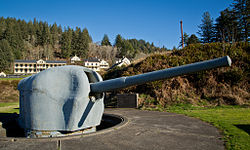| Mishaum Point Military Reservation | |
|---|---|
| Part of Harbor Defenses of New Bedford | |
| Dartmouth, Massachusetts | |
 6-inch gun at Fort Columbia State Park, Washington state, similar to Battery 210. | |
| Site information | |
| Type | Coastal Defense |
| Owner | private |
| Open to the public | no |
| Condition | built on |
| Location | |
| Coordinates | 41°30′54.84″N70°57′13.94″W / 41.5152333°N 70.9538722°W |
| Site history | |
| Built | 1943-1945 |
| Built by | United States Army |
| In use | 1943–1947 |
| Battles/wars | World War II |
| Garrison information | |
| Garrison | Fort Rodman |

Mishaum Point Military Reservation was a coastal defense site located in Dartmouth, Massachusetts as part of the Harbor Defenses of New Bedford.

